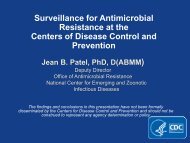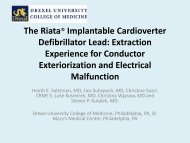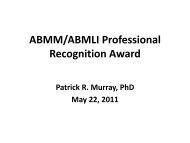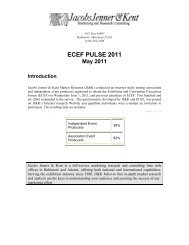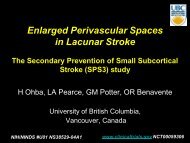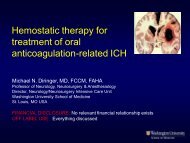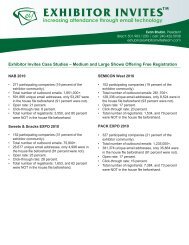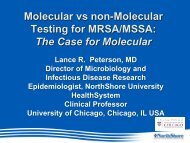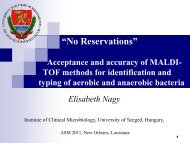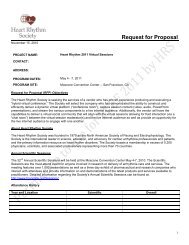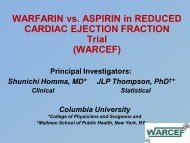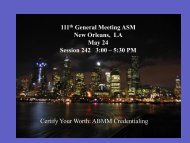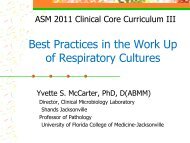S. aureus
S. aureus
S. aureus
Create successful ePaper yourself
Turn your PDF publications into a flip-book with our unique Google optimized e-Paper software.
The Skin Microbiome -<br />
Clinical Laboratory Impact on<br />
Hospital Acquired Infections Affecting<br />
Patient Outcomes<br />
ASM, New Orleans<br />
May 22, 2011<br />
Lance R. Peterson, MD<br />
Director of Microbiology and<br />
Infectious Disease Research<br />
Epidemiologist, NorthShore University HealthSystem<br />
Clinical Professor<br />
University of Chicago, Chicago, IL USA
• Research Grants<br />
Potential COI<br />
– Bayer, Cepheid, NorthShore, GeneOhm, GSK, Johnson and<br />
Johnson, Merck, MicroPhage, Nanogen, Nanosphere,<br />
NIAID, Roche, 3M, Washington Square Health Foundation,<br />
Wyeth (Pfizer), AHRQ<br />
• Consultations (in conjunction with research projects<br />
and new diagnostics)<br />
– Cepheid, GeneOhm, GSK, MicroPhage, Nanogen,<br />
Nanosphere, Roche, 3M, Wyeth (Pfizer)<br />
• Industry support for this presentation<br />
– None
Objectives<br />
• Review the relevance of the skin Microbiome to<br />
infections impacted by the clinical laboratory<br />
• Discuss the application of MRSA surveillance<br />
• Summarize the literature on pre-surgical testing<br />
for S. <strong>aureus</strong> to lower surgical site infection
Skin Ecology<br />
• Hairy, moist underarms lie a short distance<br />
from smooth dry forearms<br />
– “These two niches are as ecologically dissimilar as<br />
rainforests are to deserts”<br />
• Molecular approaches (as opposed to<br />
traditional culture) have revealed a greater<br />
diversity of skin microbiota within and<br />
between distinct topographical regions<br />
• Methicillin-resistant S. <strong>aureus</strong> acquired genes<br />
that promote growth on skin from the symbiont<br />
S. epidermidis<br />
EA Grice et al. Science 324:1190-2, 2009<br />
EA Grice et al. Nature Rev Microbiol: 9:244-253, 2011
Skin Ecology - Dominance<br />
• Propionibacteria and Staphylococcus species<br />
predominate in sebaceous sites<br />
• Corynebacteria spp. predominate in moist<br />
sites, although staphylococci also are present<br />
• A mixed population of bacteria reside in dry<br />
sites, with a greater prevalence of<br />
β-Proteobacteria and Flavobacteriales<br />
• Unique microenvironment of the anterior<br />
nares consists of moist, epithelia contiguous<br />
with noncornified nasal mucosa and drier<br />
keratinized skin EA Grice et al. Science 324:1190-2, 2009<br />
EA Grice et al. Nature Rev Microbiol: 9:244-253, 2011
Microbiome of the Nose<br />
• Studied 5 healthy carriers and 42 hospital patients<br />
– Culture-independent analysis of 16S rRNA<br />
• Healthy nares had only two bacterial phyla<br />
– Actinobacteria (i.e., High-G+C Gram positive organisms<br />
such as corynebacteria - 68% of sequences)<br />
– Firmicutes (i.e., Low-G+C Gram positive organisms such<br />
as staphylococci - 27% of sequences)<br />
– S. <strong>aureus</strong> found in the nares (of 2/5 individuals)<br />
– Nares samples similar mostly to each other (p
Microbiome of the Nose<br />
• S. <strong>aureus</strong> was most abundant in patients classified<br />
as S. <strong>aureus</strong>-carriers by femA PCR<br />
– Confirms the diagnostic utility of the femA PCR assay<br />
used to classify patients with staphylococcal species<br />
DN Frank et al. PLoS ONE 5(5):<br />
e10598. doi:10.1371, 2010
What Does this Suggest for the<br />
Clinical Laboratory?
Risk for S. <strong>aureus</strong> Infection<br />
• Systematic review (10 studies) to estimate of<br />
the risk of infection following colonization with<br />
MRSA compared with colonization by MSSA<br />
• Random effects model was used to obtain<br />
pooled odds ratio estimates<br />
• Overall, colonization by MRSA was<br />
associated with a 4-fold increase in the risk of<br />
infection (odds ratio 4.08, 95% confidence<br />
interval, 2.10-7.44) N Safdar et al. Am J Med 121:310-15, 2008
Risk for S. <strong>aureus</strong> Infection<br />
• Measured 1-year risk of MRSA infection<br />
following detection of nasal colonization<br />
– 4 hospitals over 4.5 years with 211,339 episodes<br />
• 1-year risk of MRSA infection was 11.8% for<br />
nasally colonized persons<br />
• 1-year risk of MRSA infection was 0.7% for<br />
non-colonized persons<br />
D Ridgway et al. IDSA meeting, 2011<br />
• Suggests 1-year risk of MSSA infection is<br />
2.9% for nasally colonized persons
Review of Mupirocin<br />
Decolonization<br />
• Nasal carriage of S. <strong>aureus</strong> is a defined risk<br />
factor for subsequent infection in patients<br />
• 8 studies compared mupirocin with placebo<br />
or with no treatment: Statistically significant<br />
reduction in the rate of S. <strong>aureus</strong> infection<br />
associated with intranasal mupirocin (RR<br />
0.55, 95% CI = 0.43 to 0.70)<br />
M van Rijen et al. Cochrane Database of Systematic Reviews 2008,<br />
Issue 4. Art.No.:CD006216.
Critical Review of MRSA<br />
Screening by Rapid Methods<br />
• Review and meta-analysis of randomized, nonrandomized,<br />
and observational studies<br />
– Random-effect model was used<br />
– Ten studies (nine interventional studies and one<br />
unblinded, cluster-randomized, crossover trial) reviewed<br />
• Between wards applying rapid screening tests and<br />
those without screening, noted a significantly<br />
decreased risk for MRSA bloodstream infections<br />
• Overall, concluded that active screening for MRSA<br />
is more important than the type of test used<br />
E Tacconelli et al. Lancet Infect Dis 9: 546–54, 2009
CDC Surveillance (2005)<br />
• Prospective study on MRSA risk<br />
• Nearly 9,000 cases from 9 sites (ABC surveillance)<br />
– 77% of HAI* were blood infections (2-fold rise in 6 years)<br />
– 31.8 invasive infections/100,000 persons<br />
– Nationally translates to 94,360 cases of invasive disease<br />
– 18,650 annual US deaths (greater than HIV-AIDS)<br />
• No longer well defined risk groups<br />
• 85% healthcare associated<br />
– “It is a major health problem primarily related to health care<br />
but no longer confined to intensive care units . . ”<br />
* HAI = Healthcare Associated Infection<br />
- RM Klevens, JAMA 298:1763-71, 2007
Comparative Mortality of MSSA<br />
and MRSA Bacteremia<br />
• Meta-analysis of 31 reports from 1980-2000<br />
– 3963 MSSA and 2603 MRSA cases<br />
– Significant increase in mortality noted for MRSA<br />
» OR 1.93; 95%<br />
CI = 1.54-2.42,<br />
p
US Infection Mortality 2005<br />
FR DeLeo &<br />
HF Chambers<br />
JCI 119:2464, 2009
Do Colonized Patients Spread MRSA?<br />
• Compared 58 patients with MRSA disease to<br />
57 with nasal colonization to determine risk for<br />
skin and environmental contamination<br />
– Skin and environment contaminated 50 vs 47%<br />
– Various skin sites 38-66% vs 30-63%<br />
– Various environment sites 27-60% vs 21-63%<br />
• Glove acquisition from skin 14-45% vs 16-38%<br />
• “Strategies to limit transmission must address<br />
colonized patients”<br />
S Chang et al, CID 48: 1423-8, 2009
Percent Positive on Admission<br />
25.0<br />
20.0<br />
15.0<br />
10.0<br />
5.0<br />
0.0<br />
MRSA Prevalence by Age<br />
n=18,898<br />
Disease risk* = 3.7%/year Disease risk = 8.2%/year; P=0.067<br />
0-9 10-19 20-29 30-39 40-49 50-59 60-69 70-79 80-89 90-99<br />
*Risk of invasive disease if MRSA colonized; N=993<br />
A Robicsek et al, ICHE 30:623-32, 2009<br />
Age<br />
CMS Recipients
MRSA Screening Program<br />
• Intervention: Admission MRSA screening and<br />
isolation to assure new admissions we are doing<br />
our best so they will not get MRSA from<br />
NorthShore<br />
– Start with >90% compliance<br />
• Admission order set for PCTs and nursing<br />
– Admission MRSA Screen<br />
– Choice for response either yes or refused<br />
• Treatment order package (nasal mupirocin twice<br />
daily for 5 days with chlorhexidine bathing)<br />
– Type in MRSA, and order MRSA Decolonization Panel<br />
LR Peterson et al, Jt Com J Qual Pt Safety, 33:732-8, 2007
NorthShore MRSA Program<br />
Began on August 1, 2005<br />
• Observational study in a 3-hospital, 850-bed<br />
organization with 40,000 annual admissions<br />
comparing rates of MRSA clinical disease<br />
during and 30 days after hospital admission<br />
• Real-time PCR-based nasal surveillance for<br />
MRSA followed by topical decolonization<br />
therapy and contact isolation of patients who<br />
tested positive for MRSA
Prevalence Density<br />
(Cases/10,000 patient-days)<br />
10.0<br />
9.0<br />
8.0<br />
7.0<br />
6.0<br />
5.0<br />
4.0<br />
3.0<br />
2.0<br />
1.0<br />
0.0<br />
P = 0.15<br />
Total MRSA Healthcare Infections<br />
8/03 - 7/04 9/04 - 7/05 9/05 - 7/06 8/06 - 7/07 8/07 - 7/08 8/08 - 7/09<br />
ICU surveillance Universal surveillance<br />
P ≤ 0.001<br />
Years<br />
A Robicsek et al, Ann Int Med 148:409-18, 2008<br />
70% reduction in<br />
total MRSA disease<br />
during hospitalization<br />
and 30 days post-discharge<br />
2 BSI in 3 hospitals<br />
LR Peterson et al, Decennial Meeting on<br />
Nosocomial Infections, Atlanta, 2010<br />
Total
Includes all admissions (Community and Hospital onset)<br />
Data generated solely by capturing<br />
positive clinical cultures from LIS:<br />
Chart review (n=1,194) of all positive<br />
cultures found that 77.1% represented<br />
actual infection<br />
Universal surveillance begins<br />
P
How Much Does MRSA HAI Cost?<br />
No MRSA HAI<br />
(n=5796)<br />
LOS ≥8d<br />
MRSA HAI<br />
(n=178)<br />
Mean Total<br />
Cost<br />
$50,013 $42,363,<br />
$57,662<br />
$73,795 $63,743,<br />
$83,847<br />
Excess $23,783 $16,771,<br />
$30,794<br />
95% CI Mean Profit/Loss 95% CI<br />
-$25,000 -$28,883,<br />
-$21,116<br />
-$35,479 -$42,034,<br />
-$28,923<br />
-$10,479 -$16,110,<br />
-$4,848<br />
LR Peterson et al, Jt Com J Qual Pt Safety, 33:732-8, 2007
Medical and Economic Outcome<br />
• Excess expense of MRSA infection<br />
(compared to no infection) = $24,000<br />
– Actual cost data from 178 cases/5,796 controls<br />
• During first four years of NorthShore MRSA<br />
containment program avoided 406 infections<br />
– Net expense reduction = $8.8 million<br />
– Number of deaths avoided = 72<br />
LR Peterson, JCM 48:683-9, 2010<br />
LR Peterson et al, Jt Comm J Qual Patient Saf 33:732-8, 2007<br />
RM Klevens et al, JAMA 298:1763-71, 2007
Veterans Administration<br />
Healthcare System (153 Hospitals)<br />
• Reported 21-month results of all admission<br />
screening for MRSA based on 1,312,840<br />
admissions covering 8,318,675 patient days<br />
• 45% reduction in MRSA disease in non-ICU<br />
patients (P = 0.001) throughout the system<br />
• 62% reduction in MRSA disease for ICU<br />
patients (P < 0.001)<br />
– 2 year baseline in ICU patients had no change in<br />
disease<br />
R Jain et al. NEJM 364:1419-30, 2011<br />
• Testing primarily (92%) with rtPCR methods
Cluster Randomized Trial of ICU:<br />
Demonstrated non-Utility of Culture<br />
• Assessed VRE and MRSA surveillance plus<br />
enhanced barrier precautions in the ICU<br />
• 5,434 admissions to 10 intervention ICUs, and 3,705<br />
to 8 control ICUs over 6 months<br />
– Centralized, broth enriched culture used for testing<br />
• Incidence of colonization or infection with MRSA or<br />
VRE per 1000 patient-days at risk did not differ<br />
significantly (P = 0.35)<br />
• Mean (±SD) number of days from when surveillance<br />
swab obtained until it was reported was 5.2±1.4<br />
– 41% of patient days captured after reporting<br />
WC Huskins et al. NEJM 364:1407-18, 2011
% of isolation days missed<br />
50<br />
45<br />
40<br />
35<br />
30<br />
25<br />
20<br />
15<br />
10<br />
5<br />
0<br />
Missed Isolation Day Percentage: Method Comparison<br />
† = Failed Programs<br />
* = Successful Program<br />
†<br />
Program † likely successful if capture<br />
>80% of MRSA potential isolation days<br />
*<br />
*<br />
0 3 6 9 12 15 18 21 24 27 30 33 36 39 42 45 48 51 54 57 60 63 66 69 72 75 78 81 84<br />
Turnaround Time (hours)<br />
Traditional or Chrom Agar<br />
Enrichment + Chrom Agar<br />
rtPCR<br />
Ari Robicsek, ICAAC/IDSA 2008; A Robicsek et al, An Int Med, 48:409-18, 2008; D Jeyaratnam et al, BMJ ,<br />
336;927-30, 2008; S Harbarth et al, Crit Care 10:R25, 2006; Ari Robicsek, ICAAC/IDSA 2008; K Hardy et al,<br />
Clin Microbiol Infect 10.1111/j.1469-0691.2009; WA Bowler et al. ICHE 31:269-75, 2010; WC Huskins et al.<br />
NEJM 364:1407-18, 2011<br />
†<br />
*<br />
†<br />
†
Changing Prevalence of<br />
S. <strong>aureus</strong> in Surgery<br />
• Percentage of S. <strong>aureus</strong> as a cause of<br />
Surgical Site Infection in Coronary Artery<br />
Bypass Grafting, Cholecystectomy,<br />
Colectomy and Total Hip Arthroplasty rose<br />
from 17% to 31% between 1992-2002<br />
JA Jernigan, Maryland Patient Safety Center (NNIS), January 12, 2006
NorthShore Program for Detection of<br />
Staphylococcus <strong>aureus</strong> Colonization:<br />
Process Overview<br />
• The patient is screened for S. <strong>aureus</strong> in the<br />
nose 0-28 days prior to surgery<br />
• If the test is positive, the physician will then<br />
prescribe a 5-day course of mupirocin ointment<br />
• The patient administers the nasal ointment<br />
twice a day for the 5 days in the month prior to<br />
surgery DM Hacek et al. Clin Orthop Relat Res 466:1349-55, 2008
Results of Preoperative Screening<br />
for NorthShore Hip and Knee Surgery<br />
Patients (n = 1,495)<br />
• S. <strong>aureus</strong> SSI rate of decolonized S. <strong>aureus</strong><br />
carriers was reduced 3.8-fold (P≤0.05)<br />
• Overall S. <strong>aureus</strong> infection rate in screened<br />
versus unscreened group was 0.8% versus<br />
1.7% DM Hacek et al, Clin Orthop Relat Res. 466:1349-55, 2008
Results of Preoperative Screening<br />
for NorthShore Hip and Knee Surgery<br />
Patients (n = 1,495)<br />
• Mean readmission cost for 4 patients requiring<br />
second hospitalization $17,122 (total=$68,500)<br />
• 7 SSI from other pathogens (compared to 17 from<br />
S. <strong>aureus</strong>)<br />
– No change in rate from other bacteria over time<br />
– All non-S. <strong>aureus</strong> considered superficial<br />
– None required hospitalization<br />
DM Hacek et al, Clin Orthop Relat Res. 466:1349-55, 2008
Prospective, Randomized Trial of<br />
S. <strong>aureus</strong> decolonization<br />
• Multicenter, prospective placebo controlled trial of<br />
6,771 patients between 2005 and 2007<br />
– Intervention was rtPCR screening with nasal<br />
mupirocin/chlorhexidine bath for positive patients<br />
• 808 positive patients had surgery<br />
– 4 deep infections (0.9%) occurred in the treated group<br />
– 16 infections (4.4%) occurred in the placebo group<br />
» RR 0.21; 95% CI = 0.07-0.62<br />
– LOS 1.8 days shorter in the treated group (p=0.04)<br />
– Time to infection was shorter in the placebo group<br />
(p=0.005) LGM Bode et al. NEJM 362: 9-17, 2010
Summary<br />
• The nares is an essential site for<br />
staphylococcal colonization<br />
• Surveillance for S. <strong>aureus</strong> is helpful for<br />
preventing infection in the pre-surgical setting<br />
as well as for MRSA control<br />
• The role of active surveillance is most<br />
important when:<br />
– Clinical disease is significant<br />
– Colonization precedes clinical infection<br />
– Clonal spread is important in disease escalation



